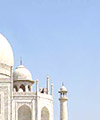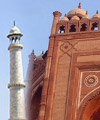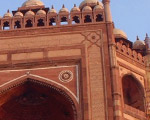 |
 |
 |
 |
 |
 |
 |
||
|
Fatehpur Sikri
Situated 40 km from Agra, the city of Fatehpur Sikri is an imperial city built by the Mughal Emperor Akbar between 1571 and 1584. The architectural grandeur of this deserted city cannot be described in words and one can only experience the aura of its magnificent edifices by seeing them. If you are looking for something that symbolizes the grandeur of the Mughals, Fatehpur Sikri is a must-see during your Taj Mahal tour in Agra. The buildings within Fatehpur Sikri are a unique blend of different architectural traditions. Though the general layout and concept of the buildings conform to the Islamic style of architecture, the actual buildings (mainly palaces), their ornate columns, arches, carving style, etc., show a strong Hindu style in general and that of Gujarat and Rajasthan in particular. Dedicated by Emperor Akbar to his patron saint Sheikh Salim Chisti, Fatehpur Sikri was also Akbar's imperial capital for fifteen years. The new city, built on a ridge, grew into a magnificent township larger than contemporary London. A splendid edifice, the fort today rests in quiet peace - a mute witness to the times gone by. There are a number of buildings within the Fatehpur Sikri complex to be savoured during your Taj holidays in Agra. Each of the small palaces in Fatehpur Sikri has a specific purpose and generally faces a courtyard. Diwan-I-Aam (Hall of Public Audience) is an enclosed space surrounded by colonnades and has a large open area where petitioners and courtiers once stood in attendance; Diwan-I-Khas (Hall of Private Audience) - used for serious, confidential, diplomatic and religious discourses - is famous for its central decorated pillar consisting of 36 elegantly carved brackets in the Gujarati style - heavy and ornate, and sprouting in shape; Panch Mahal (five-tiered palace) is an intriguing five-storied pavilion of winds. The Turkish Sultan's palace is known for exquisitely carved panels depicting wildlife-lions, birds, and foliage. Near the Diwan-I-Aam, one can see a tank called the Anup Talao. Four bridges link the central platform at the Anup Talao. Here the famous court musician Tansen played music. Jodha Bai's Palace (Jodha Bai was Akbar's Rajput queen) has the most distinctively Gujarati and Rajasthani architectural features. Also noteworthy are Mariam's Palace or Sunehra Makan (golden house), Palace of Birbal (one of Akbar's minister notable for his witticisms) and a miniature garden. Jami Masjid (mosque), sacred center of Sikri, symbolizes the city's spiritual prominence. In the vast courtyard stands the tomb of Sheikh Salim Chisti whose blessings are still sought by childless women. Excursion The monumental 54 m high Buland Darwaza, the Gate of Victory, is the main entrance. It was constructed to commemorate Akbar's victory in Gujarat. A koranic inscription upon it read, "The world is a bridge, pass over it but built no house upon it. He who hopes for an hour, hopes for Eternity, for the world is but an hour". Just outside the gateway is a deep well wherein local daredevils leap from the top of the entrance into the water. The Shahi Darwaza is the official entrance, where licensed guides can be hired.
Tomb
of Shaikh Salim Chisti Place of Jodha Bai Birbal Bhawan Karawan Serai and Hiran Minar Palace of the Christian Wife Diwan-I-Am Diwan-khana-I-khaas Turkish Sultana’s House The Treasury Daulat khana-I-khas Best time to visit
|
||||||||||
|
||||||||||
|
||||||||||
|---|---|---|---|---|---|---|---|---|---|---|